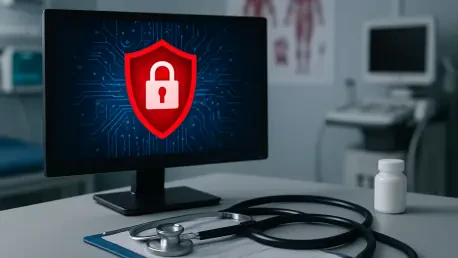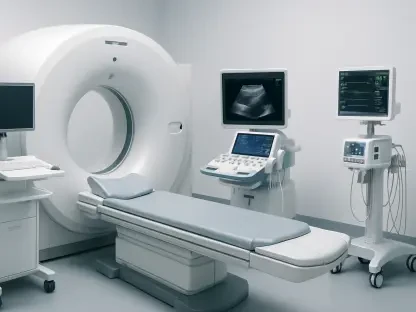In the current landscape of healthcare across the United States, a relentless surge of cybersecurity threats poses an unprecedented danger to patient safety and the integrity of medical services, with hospitals, clinics, and their interconnected business partners increasingly targeted by cybercriminals. These attackers exploit both advanced technology and human vulnerabilities, creating a crisis that demands urgent attention. Reports from esteemed organizations like the Health Information Sharing and Analysis Center (Health-ISAC), the Ponemon Institute, and Comparitech reveal a stark reality: cyberattacks are not merely data breaches but direct assaults on patient care, leading to severe clinical consequences. The urgency to address these risks has never been more critical, as the healthcare sector struggles to balance technological innovation with robust security measures.
These cyber incidents ripple through emergency rooms and operating theaters, causing delays, diversions, and, in the worst cases, loss of life. Financially, the toll is staggering, with millions drained from already tight budgets to cover ransom payments and recovery costs. Meanwhile, human errors and systemic gaps in expertise compound the problem, leaving organizations exposed to an ever-evolving array of threats. As Health-ISAC data indicates a record number of breaches in the first half of this year, the healthcare industry stands at a crossroads, compelled to fortify defenses while grappling with the interconnected nature of modern medical ecosystems.
Escalating Cyberthreats and Patient Impact
Rising Attack Frequency and Severity
The healthcare sector is under siege, with cyberattacks reaching alarming levels of frequency and sophistication this year. Health-ISAC reports over 4,040 breaches in just the first six months, a number projected to climb even higher by year-end, positioning the industry as a prime target for cybercriminals. The high value of patient data, coupled with the critical reliance on IT systems for care delivery, makes healthcare an irresistible mark for malicious actors. These attacks are not random but calculated, exploiting both technological weaknesses and the sector’s inherent urgency to maintain operations at all costs. As ransomware, cloud compromises, and other threats proliferate, the sheer volume of incidents underscores a chilling trend: no organization, regardless of size or location, is immune to this digital onslaught.
Beyond the numbers, the severity of these breaches paints a grim picture for the future of healthcare security. Many of these incidents disrupt essential services, forcing providers to divert resources from patient care to crisis management. The expectation of continued growth in breaches from this year into the next highlights a persistent vulnerability that cybercriminals are eager to exploit. Supply chain attacks, in particular, have emerged as a significant vector, amplifying the reach of a single breach across multiple entities. This escalating threat landscape demands a reevaluation of current defenses, as the consequences of inaction are measured not just in data loss but in human lives.
Direct Consequences for Patient Care
Cyberattacks are no longer confined to the realm of IT departments; their impact reverberates directly into patient care with devastating effects. A joint survey by Proofpoint and the Ponemon Institute reveals that 72% of healthcare organizations experiencing cyberattacks this year reported disruptions to care delivery, a troubling increase from previous findings. These disruptions manifest as increased complications during medical procedures for 54% of affected entities, extended hospital stays for 53%, and, most alarmingly, a 29% rise in mortality rates linked to these incidents. The human cost of such breaches transforms abstract data points into tangible tragedies, where a delayed surgery or inaccessible record can alter patient outcomes irreversibly.
The mechanisms of these disruptions are as varied as they are damaging, with ransomware often forcing hospitals to divert patients to other facilities, as reported by 50% of impacted organizations. Longer hospital stays, noted in 67% of ransomware cases, strain already limited resources and exacerbate patient suffering. These clinical consequences are not mere side effects but central to the crisis, illustrating how deeply cybersecurity failures infiltrate the core mission of healthcare. As threat actors refine their tactics to maximize disruption, the link between digital security and patient safety becomes undeniable, pressing the industry to prioritize resilience in ways previously unimagined.
Financial and Operational Strain
Soaring Costs of Cyber Incidents
The financial burden of cyberattacks on healthcare organizations is a crushing weight that threatens fiscal stability across the sector. While the average cost of a major cyber incident has slightly decreased to $3.9 million this year, the rise in ransomware payments tells a different story, with the average ransom now standing at $1.2 million, up from $1.1 million last year. These payments, often made under duress to restore critical systems, drain budgets that could otherwise fund patient care or infrastructure improvements. The economic impact extends beyond direct costs, encompassing fines, legal fees, and the expense of rebuilding trust with patients whose data has been compromised.
Moreover, the financial strain is not evenly distributed, with smaller organizations often bearing a disproportionate burden relative to their resources. The need to allocate funds for cybersecurity measures competes with other pressing priorities, creating a dilemma where patient services may be cut to cover security gaps. High-profile ransom demands, sometimes exceeding $1 million as seen in recent cases, highlight the predatory nature of these attacks, designed to exploit the urgency of restoring medical operations. As these costs mount, the healthcare sector faces a stark reality: without significant investment in prevention, the price of recovery will continue to escalate, siphoning resources from the very mission of healing.
Operational Disruptions and Recovery Challenges
Beyond the balance sheet, cyberattacks inflict profound operational disruptions that ripple through healthcare delivery systems. When systems are compromised, patient diversions become a grim necessity, with half of ransomware-hit organizations forced to redirect individuals to other facilities, often at great personal and logistical cost. Delayed treatments, a common fallout reported by numerous providers, exacerbate existing health conditions and erode patient trust in the system. These interruptions are not fleeting; they create a domino effect, overwhelming staff and straining capacity as organizations scramble to restore normalcy while managing ongoing care demands.
Recovery from such incidents is neither quick nor guaranteed, with many healthcare entities facing prolonged downtime that hinders their ability to serve communities effectively. The process often involves rebuilding entire IT infrastructures, retraining staff, and implementing new protocols under intense scrutiny. Each day of disruption translates to missed appointments, postponed surgeries, and heightened risks for vulnerable patients. The cascading effects of these operational challenges underscore a critical need for proactive measures, as the cost of reacting after an attack far exceeds the investment in robust defenses. Until these recovery challenges are addressed, the cycle of disruption will persist, undermining the core function of healthcare providers.
Root Causes and Vulnerabilities
Human Error as a Key Weakness
At the heart of many cybersecurity failures in healthcare lies a pervasive and often overlooked factor: human error. A staggering 96% of organizations have encountered multiple data loss incidents over the past two years due to employee negligence or insider risks, averaging 18 such events per entity. Simple mistakes, like sending sensitive information to the wrong recipient or failing to adhere to security protocols, open doors for cybercriminals to exploit. These errors are not born of malice but of insufficient training and a lack of cyber awareness, which remain persistent challenges across the sector despite the growing threat landscape.
The consequences of these human-driven incidents are far-reaching, with over half of affected organizations reporting direct impacts on patient outcomes. The connection between a misplaced email or a clicked phishing link and a delayed medical procedure is stark, revealing how individual actions can have systemic repercussions. Addressing this root cause requires more than technology; it demands a cultural shift toward prioritizing cybersecurity education at every level of an organization. Until staff are equipped with the knowledge and tools to recognize and prevent risks, human error will continue to serve as a primary gateway for attackers, perpetuating a cycle of vulnerability that undermines patient safety.
Exploited Technological Flaws
Technological vulnerabilities in healthcare systems provide another critical entry point for cybercriminals seeking to disrupt operations. Widely used infrastructure components like Citrix Netscaler and Cisco Adaptive Security Appliances (ASAs) have become prime targets, as attackers exploit known flaws to gain unauthorized access to essential applications such as electronic health records (EHRs). These systems, integral to managing patient data and clinical workflows, are often outdated or improperly configured, leaving them exposed to sophisticated threats that can paralyze entire networks with a single breach.
The exploitation of these technological weaknesses is not a theoretical risk but a documented reality, with Health-ISAC issuing hundreds of alerts this year alone to warn of specific vulnerabilities in member infrastructures. Once attackers infiltrate these systems, the damage can be catastrophic, locking providers out of critical tools needed for diagnosis and treatment. The reliance on interconnected digital platforms, while necessary for modern care, amplifies the impact of a single flaw across multiple facilities. Strengthening these technical defenses requires not only timely updates and patches but also a comprehensive approach to risk assessment, ensuring that the backbone of healthcare IT is fortified against the relentless ingenuity of cyber adversaries.
Emerging Defenses and Persistent Barriers
AI as a Promising Defense Tool
Amid the escalating cyberthreats facing healthcare, artificial intelligence (AI) emerges as a beacon of hope in bolstering security measures. This year, 57% of surveyed organizations have integrated AI into their cybersecurity strategies, with 55% of those adopters finding it highly effective in detecting and mitigating risks. AI’s ability to analyze vast amounts of data in real time enables the identification of suspicious patterns and potential breaches before they escalate, offering a proactive layer of defense that traditional methods often lack. This technological advancement is particularly valuable for resource-strained entities, where budget constraints limit the scope of manual oversight.
However, the adoption of AI is not without its challenges, as protecting the sensitive patient data used within these systems remains a significant concern. Cybercriminals are quick to adapt, targeting AI tools themselves to extract valuable information or disrupt their functionality. While the potential of AI to transform cybersecurity is undeniable, its implementation must be paired with stringent safeguards to ensure that the cure does not become a new vulnerability. As the healthcare sector continues to embrace this innovation, balancing efficacy with data protection will be paramount to sustaining trust and effectiveness in the fight against digital threats.
Leadership and Expertise Shortfalls
Despite technological advancements, systemic barriers in leadership and expertise continue to hinder healthcare organizations from mounting effective cybersecurity defenses. Surveys indicate that 43% of entities cite a lack of skilled personnel as a major obstacle, while 40% point to insufficient leadership in prioritizing and guiding security initiatives. These gaps create a fragmented approach to risk management, where critical decisions are delayed or misaligned with the evolving nature of cyberthreats. Without clear direction from the top, efforts to implement robust strategies often falter, leaving systems and patients exposed.
The absence of expertise exacerbates this issue, as many organizations struggle to attract and retain professionals with the specialized knowledge needed to counter sophisticated attacks. This shortfall is not merely a staffing problem but a strategic one, as the complexity of threats like ransomware and supply chain breaches demands nuanced understanding and swift action. Bridging these gaps requires investment in training, recruitment, and fostering a culture where cybersecurity is a core organizational value. Until leadership and expertise are aligned with the scale of the challenge, healthcare will remain a step behind cybercriminals, unable to fully protect the critical services it provides.
Supply Chain and Threat Actor Dynamics
Third-Party Risks Amplify Threats
The interconnected nature of the healthcare ecosystem introduces a profound vulnerability through third-party and supply chain attacks, which have surged by 30% in ransomware incidents this year. Business partners, including pharmaceutical manufacturers and health tech companies, have become frequent targets, with over 6 million records breached globally through confirmed third-party compromises. When a supplier or vendor is infiltrated, the fallout cascades across the network, disrupting operations for multiple organizations and compromising patient data on a massive scale. This ripple effect underscores how a single weak link can jeopardize an entire chain of care delivery.
These supply chain breaches are particularly insidious because they often exploit trust between entities, bypassing direct defenses to strike at less-secure partners. The resulting disruptions, reported by 87% of targeted organizations, include delayed shipments of critical supplies and halted access to shared systems, both of which directly impair patient care. Addressing this threat demands a collaborative approach, where rigorous vetting of partners and shared security standards become non-negotiable. As cybercriminals continue to exploit these interconnected vulnerabilities, the healthcare sector must prioritize collective resilience, recognizing that no organization stands alone in this digital battlefield.
Prolific Cybercriminals Targeting Healthcare
Driving the surge in healthcare cyberattacks are prolific threat actors such as SafePay, INC, Qilin, RansomHub, and Medusa, whose aggressive tactics have wreaked havoc across the sector. SafePay, for instance, has emerged as a dominant force, targeting diverse healthcare entities with relentless precision, while Qilin boasts of stealing massive datasets, including thwarted attempts to extract over 11 terabytes from a single medical center. These groups employ sophisticated ransomware strains and extortion strategies, often demanding ransoms exceeding $1 million, as seen in high-profile cases like the Rhysida attack on a regional medical center with a $1.15 million demand.
The impact of these threat actors extends beyond financial extortion, as their attacks are designed to maximize disruption to patient care and operational stability. By locking down critical systems or leaking sensitive data, they create a dual pressure of recovery costs and reputational damage. Health-ISAC and other bodies regularly issue warnings about these groups, yet their adaptability keeps them ahead of many defenses. Combating such adversaries requires not only technological innovation but also international cooperation to track and dismantle their networks. As these cybercriminals refine their methods, the healthcare industry must remain vigilant, anticipating the next move in a high-stakes game where patient lives hang in the balance.









